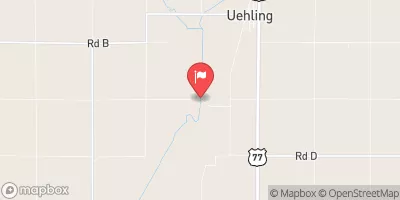Cameron Dam Reservoir Report
Nearby: Mathiesen Dam 159 Behrendt Dam
Last Updated: January 4, 2026
Cameron Dam, located in Washington, Nebraska, is a privately owned structure designed by the USDA NRCS with a primary purpose of flood risk reduction.
°F
°F
mph
Wind
%
Humidity
Summary
Completed in 1977, this earth dam stands at 36 feet tall with a hydraulic height of 33 feet and a length of 264 feet. It has a storage capacity of 119 acre-feet and serves a drainage area of 3.3 square miles. Despite its low hazard potential, the dam's condition assessment in 2017 was deemed poor, highlighting the need for maintenance and improvements.
Managed by the Nebraska Department of Natural Resources, Cameron Dam is subject to state regulation and inspection to ensure its safety and functionality. The dam's location on TR-New York Creek and its importance in flood risk reduction make it a crucial water resource infrastructure in the region. With a maximum discharge capacity of 679 cubic feet per second, the dam plays a key role in managing water levels and mitigating flood risks for the surrounding area.
While Cameron Dam has been in operation for several decades, ongoing assessments and inspections are necessary to address its poor condition and ensure its continued effectiveness in flood risk reduction. As climate change brings about more frequent and severe weather events, the maintenance and upkeep of infrastructure like Cameron Dam will be vital in safeguarding communities and water resources in the face of changing climatic conditions.
Year Completed |
1977 |
Dam Length |
264 |
Dam Height |
36 |
River Or Stream |
TR-NEW YORK CREEK |
Primary Dam Type |
Earth |
Surface Area |
6 |
Hydraulic Height |
33 |
Drainage Area |
3.3 |
Nid Storage |
119 |
Structural Height |
36 |
Hazard Potential |
Low |
Foundations |
Soil |
Nid Height |
36 |
Seasonal Comparison
Weather Forecast
Nearby Streamflow Levels
 Logan Creek Near Uehling
Logan Creek Near Uehling
|
359cfs |
 Maple Creek Near Nickerson
Maple Creek Near Nickerson
|
57cfs |
 Platte River Nr Leshara
Platte River Nr Leshara
|
5270cfs |
 Elkhorn River At Waterloo
Elkhorn River At Waterloo
|
1410cfs |
 Soldier River At Pisgah
Soldier River At Pisgah
|
112cfs |
 Big Papillion Cr
Big Papillion Cr
|
38cfs |
Dam Data Reference
Condition Assessment
SatisfactoryNo existing or potential dam safety deficiencies are recognized. Acceptable performance is expected under all loading conditions (static, hydrologic, seismic) in accordance with the minimum applicable state or federal regulatory criteria or tolerable risk guidelines.
Fair
No existing dam safety deficiencies are recognized for normal operating conditions. Rare or extreme hydrologic and/or seismic events may result in a dam safety deficiency. Risk may be in the range to take further action. Note: Rare or extreme event is defined by the regulatory agency based on their minimum
Poor A dam safety deficiency is recognized for normal operating conditions which may realistically occur. Remedial action is necessary. POOR may also be used when uncertainties exist as to critical analysis parameters which identify a potential dam safety deficiency. Investigations and studies are necessary.
Unsatisfactory
A dam safety deficiency is recognized that requires immediate or emergency remedial action for problem resolution.
Not Rated
The dam has not been inspected, is not under state or federal jurisdiction, or has been inspected but, for whatever reason, has not been rated.
Not Available
Dams for which the condition assessment is restricted to approved government users.
Hazard Potential Classification
HighDams assigned the high hazard potential classification are those where failure or mis-operation will probably cause loss of human life.
Significant
Dams assigned the significant hazard potential classification are those dams where failure or mis-operation results in no probable loss of human life but can cause economic loss, environment damage, disruption of lifeline facilities, or impact other concerns. Significant hazard potential classification dams are often located in predominantly rural or agricultural areas but could be in areas with population and significant infrastructure.
Low
Dams assigned the low hazard potential classification are those where failure or mis-operation results in no probable loss of human life and low economic and/or environmental losses. Losses are principally limited to the owner's property.
Undetermined
Dams for which a downstream hazard potential has not been designated or is not provided.
Not Available
Dams for which the downstream hazard potential is restricted to approved government users.

 Cameron Dam
Cameron Dam